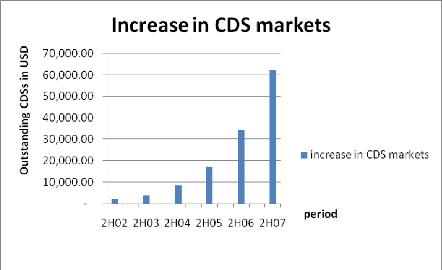2.12.2.2 CDS Netting
As far as any CDS contract is involved, the protection buyer
as well as the protection seller of credit protection takes on counterparty
risk in which it is spelt out that the protection buyer needs to take the risk
which the protection seller will default in future. There exists this `double
default' that only pops up when the triple A bank and the risky corporation
default at
the same time thereby resulting in the protection buyer losing
his protection against default by the supposed reference entity. At the same
time, if either the triple `A' bank defaults but the risky corporation does
not, then the protection buyer might need to replace the defaulted CDS but
doing so at a very high cost.
Contrary to the above, the protection seller sometimes take
the risk assuming the protection buyer will default on the contract thereby
depriving the protection seller of any expected revenue stream. The protection
seller and protection buyer both have different ways of handling the risks. The
protection seller limits his risks by buying protection from another party
hence hedging its exposure. If the original protection buyer drops out as a
result of this, the protection seller doubles his position by either unwinding
the hedge transaction or by selling a new CDS to a third party. Pending on
market conditions the price at the time may be lower than that of the original
CDS thereby implying a loss to the protection seller and vice-versa.
For instance let's consider an investor buying a CDS from a
triple `A' rated bank having a risky corporation as the reference entity. In
this case, the protection buyer of the protection is the investor who will make
regular payments to the triple `A' rated bank-the protection seller of the
protection. Note that should the risky corporation default on its debt, the
investor will eventually receive a one-time payment from the triple `A' bank
terminating the CDS contract.
The first ever existed CDS was in the early 1990s although the
market only increased at the beginning of 2003 up to the end of 2007 and fell
by the end of 2008. The increase of these CDSs during this period is because
the CDSs help in completing markets to investors since they provide effective
means to hedge and trade credit risk. This is achieved by the CDSs allowing
credit risk to be hedged separately from interest rates. Also, CDSs allow
financial institutions to manage their exposures better thereby making it
possible for investors to
benefit from enhanced investment. In addition to this, CDSs
spreads provide a valuable market-based assessment of credit conditions. The
strong growth of this CDS market is because of financial institutions' desire
of better managing credit risk and of traders gaining exposure to the credit
markets. All in all, the main reason behind the growth of the CDS markets
during this period was because most banks used the CDS spreads as a measure of
their credit risk as well as their risks management tool (buying credit
protection through CDS). CDSs were used as trading tools as well as a means of
allocating risks efficiently.
The major reason for the fall of the CDS markets by the end of
2008 was as a result of the collapse of Lehman Brothers. As if this is not
enough, it is argued that the enhanced transparency in CDS would instead result
in lowering the risks of excessive market reactions. A case in point is the
collapse of Lehman Brothers which provided a vivid example on how insufficient
transparency may result to market reactions overshooting.
Table 3: The ISDA Market Survey for CDSs
Notional amounts (in billions of US dollars), semiannual data,
all surveyed contracts, 2002- 2009
|
Period
|
CDS Outstanding (billions of USD )
|
|
2H02
|
2,191.57
|
|
2H03
|
3,777.40
|
|
2H04
|
8,422.28
|
|
2H05
|
17,096.14
|
|
2H06
|
34,422.80
|
|
2H07
|
62,173.20
|
Figure 8: Increase in CDS Markets

Source: ISDA Market Survey
The graph above illustrates an increment in the CDS markets.
The increase was as a result of how investors used these CDSs for many reasons
such as hedging and trading risks as well as in managing their exposures.
Most of the time, credit events are referred to as defaults
and they include events such as failure to pay, restructuring and bankruptcy.
In situations where the reference entity defaults, the triple `A' bank pays the
investor the difference between the par value and the market price of the
specified debt obligation. This is mostly referred to as cash settlement.
The major difference existing between insurance and CDS is
that insurance contracts provide indemnity against losses suffered by policy
holders while the CDS contracts provide equal payout to all holders, using the
agreed, market-wide method of calculation. As if that is not enough, with
insurance contracts, all the risks involved needed to be disclosed whereas
with
CDSs they are no such requirement. The CDSs protection sellers
are not required to maintain any capital reserves to serve as guarantee payment
of claims unlike the insurance companies where it is a necessity.
Defaults are usually referred to as credit events since they
entail events such as failure to pay, restructuring and bankruptcy. Statistics
show that most CDSs range between $10 to $20 million with maturities varying
between 1 and 10years. Most of the time, the bond holders buy protection so as
to hedge their risks of default thereby making CDS to be similar to credit
insurance though different from some other governing regulations.
| 

